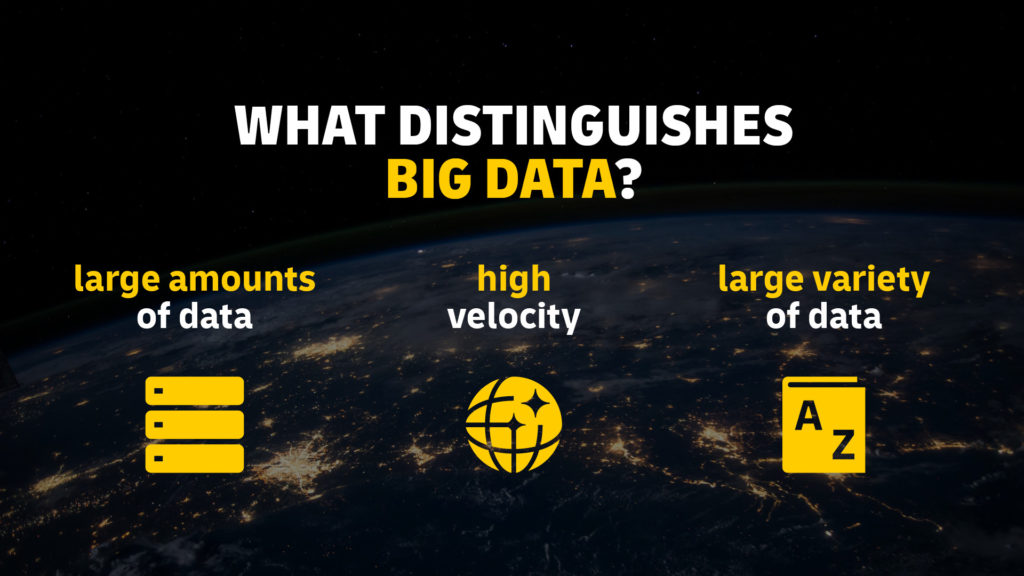
Work processes in logistics generate vast amounts of data along the supply chain. Big data analytics – the targeted processing and use of this data – offers logistics service providers tremendous potential to maintain operational standards and increase efficiency. We illustrate how data can be utilizedin logistics to promote consistent and customer-focused process optimization.
What Is Big Data?
Big data refers to data sets whose size or properties exceed the capabilities of traditional databases. Big Data is characterized by one or more of the following features: large data volumes, high velocity, or great variety of data. Artificial intelligence, social media, and the internet of things are increasing data complexity.
Data is initially just a raw material like rough diamonds – its value is inherent, but without systematic processing it is as worthless as a rough diamond is unsuitable for a diadem. The data information must be merged with experience and expertise to generate exploitable knowledge via big data analytics.
The analysis of large amounts of data reveals patterns from the past, identifies changes in the status quo in real time, and creates forecasts for the future. A distinction can be made between structured data and unstructured data:
- Structured data consists of specific figures from conventional operating systems that are stored in a searchable and predefined format. They provide immediate information on internal company key figures, are perfectly organized, and can be used directly.
- Unstructured data is obtained from scattered, disparate data sources, for example, motion data from vehicles, other traffic data, business and general economic forecasts, online user behavior, or social media posts. Unstructured data must be cleaned up and prepared for interpretation.

Big Data in Logistics Industry: Why and How Does it Help?
In logistics, every process generates empirical values that are available as data. In every movement, every transported item, or every system, there is information that can be collected and stored for evaluation. The conclusions drawn from the information are used to create forecasts and automate processes.
Big data analyses thus increase transparency in the supply chain and facilitate decision-making. This allows for strategic optimization of individual steps in the supply chain and significantly improves the level of service. The spectrum here ranges from more efficient pallet storage in a facility to a better handling of customer concerns.
One huge opportunity in big data analytics is to provide logistics players with an organized, filtered, and comprehensible real-time overview of the current situation in logistics centers or in transit. Data processing from sensors gives a precise insight into where assets such as vehicles are located and their current status – for example, whether they are being used, are broken, or when the next maintenance should take place. Damaged equipment is identified before it breaks down.
Broadly speaking, big data analytics can give logistics companies the transparency they need to improve the storage of shipments and transportation, as well as the utility and lifespan of equipment and facilities.

Big Data Logistics: Use Cases
The overarching goal of big data analytics is to safeguard operational standards and increase efficiency. Transparent operational data and its specific analysis reduce costs, maintain value, improve services, and avoid waste and risks.
Stock and Storage Control
Recording and monitoring all inventory data implies knowing where to find required supplies in the warehouse at any given time. Analyzing inventory data from systems and from sensors helps determine if stocks are running low or if pallet racks are empty. Inventory forecasts can be made to predict the expected pattern of incoming orders and deliveries during the upcoming peak and off-peak seasons.
Route Optimization
This is not just about the shortest route from point A to point B. Vehicle information, product data, GPS data, weather data, and even shift schedules all go into calculating the best possible route for a particular vehicle with its specific load. In big data analytics, all the various factors are considered and evaluated to determine the route to choose.
The best route is not necessarily the fastest. Security issues are also important. In case of goods that are sensitive to shock, for example, routes are chosen that avoid cobblestones, while shock sensors monitor the safety of the goods being transported. In addition, data on fuel consumption and driving behavior, as well as environmental data measured via vehicle sensors, can calculate the eco-balance of deliveries and enhance the routing in terms of environmental impact as well.
Capacity Planning
Vehicles, storage space, or personnel are important factors for the achievable handling capacity. With the help of big data analytics, the utilization and availability of these various capacity factors are compared for each individual logistics process step in different demand situations. This facilitates capacity forecasts. Machine and vehicle capacities are matched with staff capacities or available vehicles with demand peaks. Overcapacity is expensive and undercapacity reduces service performance and consequently customer satisfaction. If all capacities are perfectly matched via big data, overcapacities and undercapacities can be avoided.
Risk Management
Risk management also benefits from improved forecasting. Recurring events in specific processes are analyzed, making patterns and the probability of these events more transparent. Factors that have repeatedly led to disruptions in the supply chain are identified and measures to eliminate them become possible.
Customer Satisfaction
Accurate knowledge of customer preferences strengthens customer loyalty. There is a huge amount of unstructured data on customer-specific likes and dislikes from all kinds of information channels. With big data analytics, they can be systematically processed to optimize customer service. When big data provides a comprehensive overview of customer needs, service quality and customer satisfaction can be increased.
How Will Big Data Shape the Future of Logistics?
Logistics represents a data-intensive work environment. Hence, the move to a comprehensive application of big data is only logical. Most players are already convinced that the effective evaluation and use of big data will define supply chain management in the future and can improve quality and performance in the logistics industry. The task at hand is to exploit the potential of the data and make it usable. The need for data analytics is growing with the internet of things, artificial intelligence, cloud computing, and blockchain solutions – all of which are interrelated to big data. While today big data already supports route or maintenance planning in many cases, in the future its predictive capabilities will be more and more in focus. This could be forecasts of departure times and delivery dates within the entire supply chain or the prediction of demand and transport volumes.
Why Logistics Companies Should Turn to Big Data
Data is too valuable not to use. It is the basis for the future automatic control of logistics processes within a transparent value chain. In a highly competitive market, it is crucial for successful players to optimize processes for their future viability. Improved analytical processes, especially in light of increasing cross-company data exchange in the supply chain, are becoming a driver of business success. Not only in logistics.
Frequently Asked Questions
- What is big data
Big data relates to data sets characterized by large amounts of data, high velocity, or large variety of data. The analysis of this data reveals patterns from the past, indivates changes, and creates projections for the future. - What are the benefits of big data?
Big Data analytics ensures operational standards and increases efficiency. Big data allows for reducing costs, preserving value, improving services, and eliminating waste and risk. - How can big data be helpful for logistics?
Logistics processes generate a lot of data which, when utilized in a targeted manner, can improve logistics services. Data is the basis for the future automatic control of logistics processes within a transparent value chain. Big data analysis is becoming increasingly important, especially when it comes to forecasting demand or capacity.



